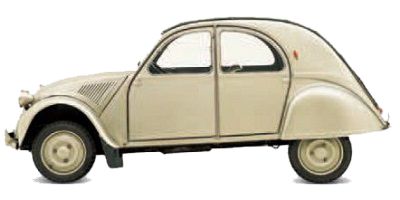At the Paris motor show in October 1948, the 2CV caused astonishment, even though it had been scheduled to appear eight years earlier. The original launch was cancelled when World War II broke out. All but one of the 250 prototypes were destroyed to preserve the ingenious car’s secrets.

Citroën 2CV 1948
- YEAR REVEALED 1948
- PLACE OF ORIGIN Paris, France
- HISTORICAL STATUS production car
- ENGINE flat twin-cylinder, 23ci (375cc)
- MAXIMUM POWER 9bhp
- LAYOUT front-mounted engine driving the front wheels
- BODYWORK four-door four-seater sedan
- TOP SPEED 40mph (64kph)
- NUMBER BUILT 3,868,634
It expressed a new philosophy for Citroën, being the lightest of lightweight economy cars, powered by a newly designed air-cooled flat-twin engine of a mere 23ci (375cc), front-wheel drive, and the first four-speed gearbox Citroën had ever fitted as standard. Its corrugated hood gave the appearance of a wartime air-raid shelter on wheels. The “father” of the 2CV was Citroën’s managing director, Pierre Boulanger.
He briefed his chief engineer Maurice Broglie to come up with an “umbrella on wheels” that could travel in comfort over rural roads and cost a third of the price of a family sedan. The tight-knit team that designed the car, led by André Lefebvre, more than rose to the challenge, and continued work on the car during the war.
After several concepts had been tried out, using a test track built in the grounds of an isolated chateau outside Paris, Citroën settled on a light, gauge steel body and soft, long-travel interconnected suspension featuring horizontal coil springs. Low-pressure Michelin Pilote tires made sure it could float over any pothole. Showgoers in 1948 might have been uncertain as to the utilitarian new Citroën, but it rapidly became part of the fabric of French life, both rural and urban.